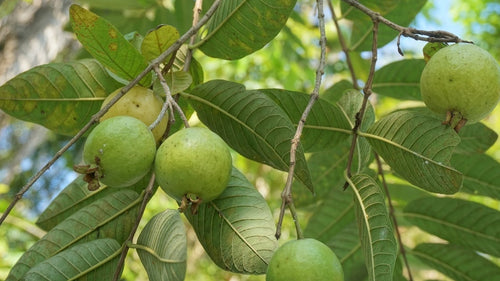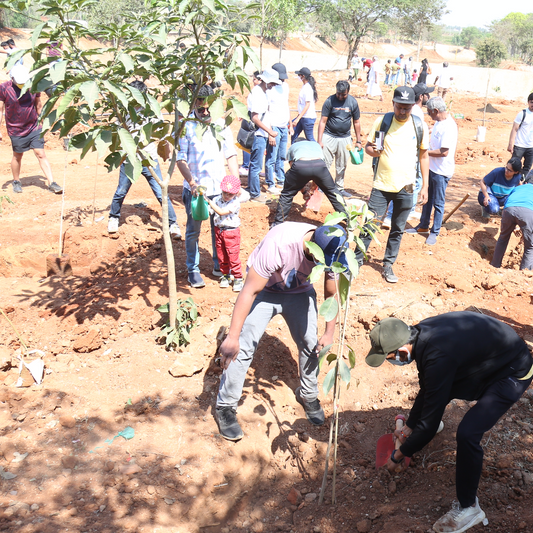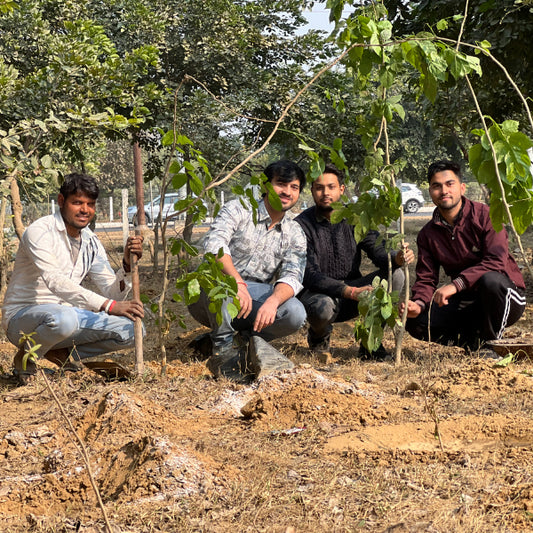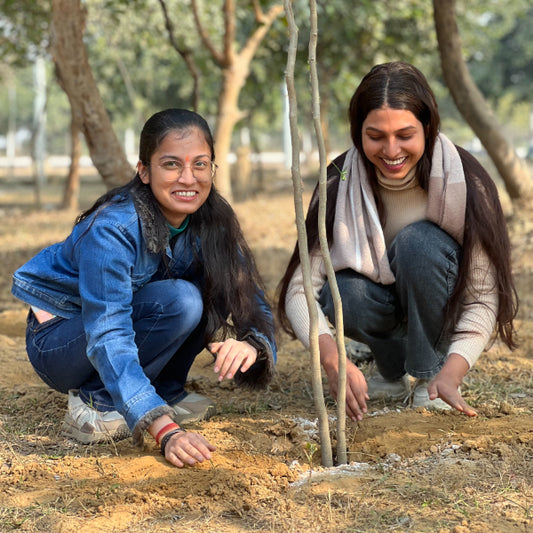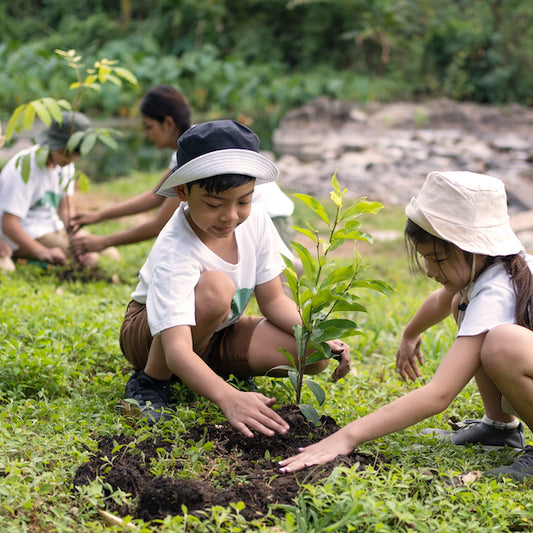A Step Toward Sustainability: SIRO Clinpharm’s New Year Tree Plantation Initiative for a Greener, Healthier Future
SIRO Clinpharm’s New Year Tree Plantation Drive is a remarkable initiative that underscores the company’s commitment to environmental sustainability, Read more
Plantation Site Gallery
Project Update 1
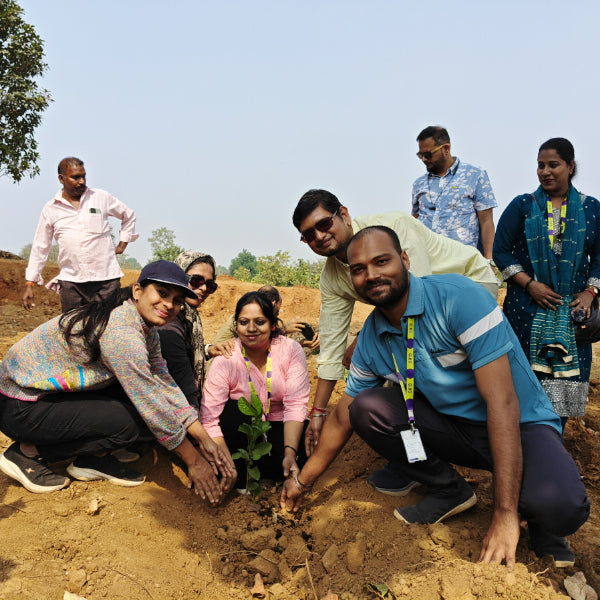

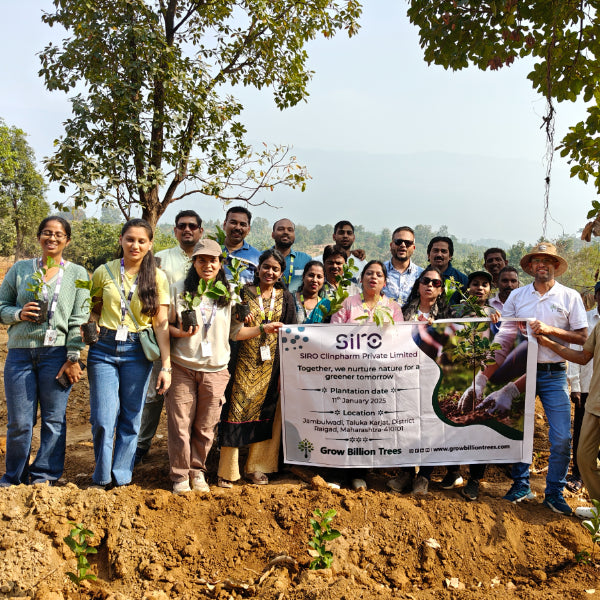
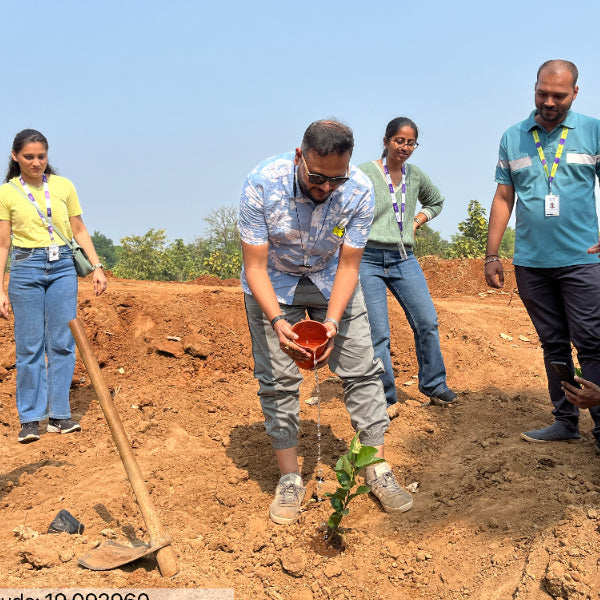
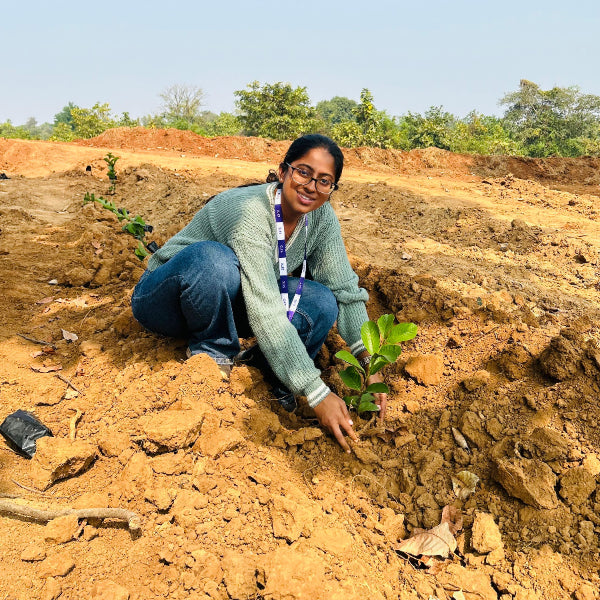
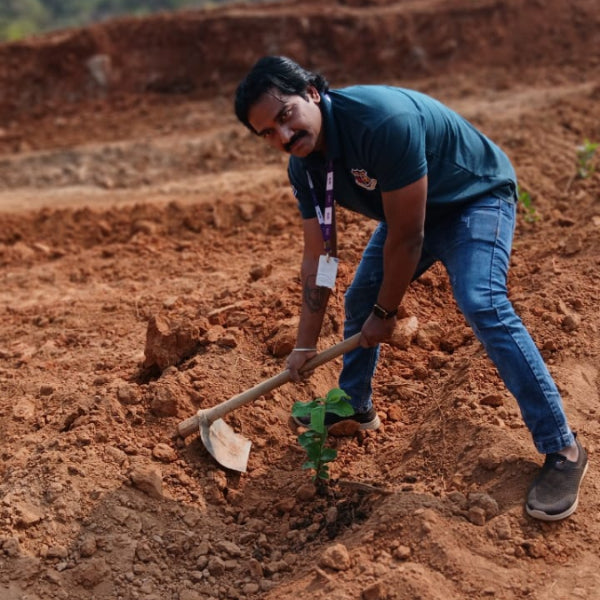
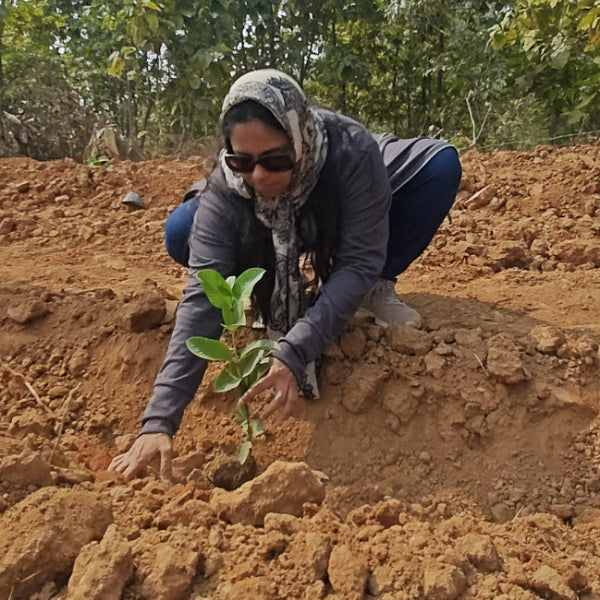
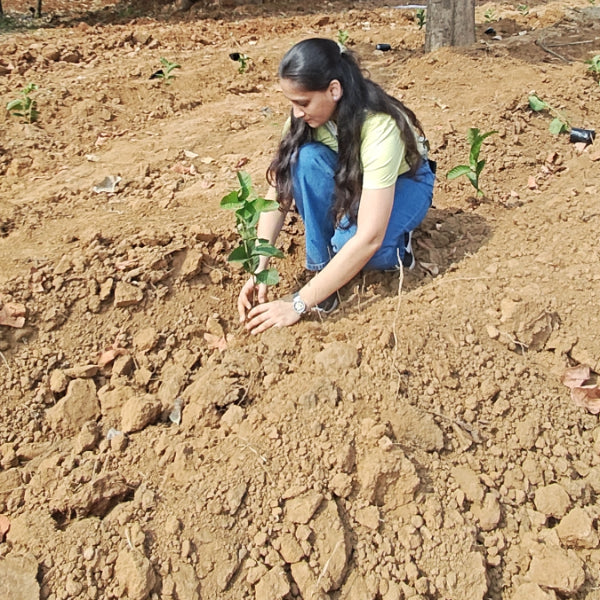
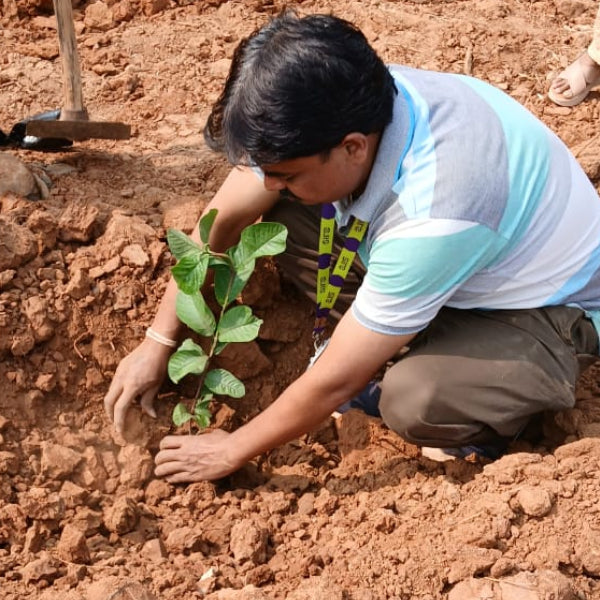

Digital Forest
Forest with 2,000 Trees planted
A Step Toward Sustainability: SIRO Clinpharm’s New Year Tree Plantation Initiative for a Greener, Healthier Future
SIRO Clinpharm’s New Year Tree Plantation Drive is a remarkable initiative that underscores the company’s commitment to environmental sustainability, community empowerment, and corporate responsibility. Established in 1996, SIRO Clinpharm is a renowned Clinical Research Organisation (CRO) offering a spectrum of services across clinical trials, data analytics, and medical writing. With a global delivery center in Thane housing over 200 skilled professionals, the company’s dedication to excellence now extends to nurturing the environment.
This impactful tree plantation drive, in collaboration with Grow Billion Trees, adopts the agroforest concept an approach that seamlessly integrates forestry with sustainable farming. By combining tree plantation with agriculture, the initiative enhances biodiversity, promotes ecosystem health, and directly supports farmers. Agroforestry provides farmer-centric benefits such as enhanced income diversification through the sale of fruits, timber, and other tree-based products, improved livelihood resilience against climate uncertainties, and reduced farming costs through natural soil enrichment and pest control. This thoughtful approach not only uplifts farming communities but also strengthens their long-term sustainability.
At the heart of this initiative is employee engagement. SIRO’s diverse team actively participates in creating a greener planet, fostering a sense of ownership and collective responsibility for the environment. By engaging with farmers and understanding the importance of sustainable practices, employees gain a deeper appreciation of their role in environmental conservation.
The New Year Tree Plantation Drive serves as more than just a corporate activity it’s a symbol of hope and an enduring commitment to sustainability. It unites employees, farmers, and communities to work toward a shared vision: a healthier, greener planet for future generations. Through this initiative, SIRO Clinpharm demonstrates that every step toward sustainability no matter how small creates a ripple effect, inspiring positive change and contributing to a better world.
Project Planning & Execution
No of Trees: 2000
Plantation Location: Jambulwadi, Taluka Karjat, District Raigad 410101
Plantation Date: 11th January 2025
Name of Species: Guava
Species Selection & Its Benefits:
The project emphasizes planting native tree species, ensuring high survival rates and long-term ecological health while aligning with local market demand to provide the farmer with viable income opportunities. Farmer consent is integral to the selection process, ensuring species complement existing agricultural practices.
The project strategically selected Guava (Psidium guajava) trees for plantation due to their multiple ecological, economic, and social benefits. Hardy and low-maintenance, Guava provides a reliable income through its fruit while enriching soil fertility, reducing erosion, and creating a favourable microclimate for crops. This thoughtful selection supports both environmental sustainability and the economic stability of local communities.
Beneficiaries Details
The GBT team began the search for a suitable farmer by conducting door-to-door visits and engaging in detailed discussions to assess land suitability and willingness to adopt agroforestry practices. After evaluating several candidates, Mr. Shivram Parthian, a marginal farmer with a 2.5-acre landholding, was selected. Fully dependent on farming for his livelihood, Mr. Parthian had previously been cultivating watermelon with limited income.
Once introduced to the benefits of agroforestry, including improved soil health, better water retention, and increased income potential, he expressed interest in the project. A consent form was signed to formalize his participation, and he received technical training on tree planting and maintenance, supported by regular expert visits to ensure the project's successful implementation. This collaboration ensures the farmer’s active involvement and the long-term success of the agroforestry system.
Planting Methodology and Its Advantages
Agroforestry: Agroforestry, as implemented in SIRO Clinpharm’s plantation initiative at Jambulwadi, is a sustainable land management practice that seamlessly integrates trees with local agricultural crops. This approach enhances soil fertility, conserves water, and reduces erosion through the natural processes of the trees, contributing to a healthier ecosystem. By combining tree plantation with farming, the methodology not only supports biodiversity by creating habitats for various species but also boosts agricultural productivity through the provision of shade, wind protection, and natural pest control.
For SIRO Clinpharm, this agroforestry model offers a dual benefit: it helps farmers diversify their income streams by enabling them to harvest fruits and other tree-based products alongside traditional crops, ensuring greater economic stability. This holistic approach aligns with SIRO’s commitment to environmental sustainability, community empowerment, and long-term agricultural resilience, reinforcing the company’s responsibility to foster a greener, more sustainable future for all.
Advantages of Agroforestry
-
Increased Farmer Incomes: This approach helps in increasing the farmer’s income by as much as 3 times. Farmers benefit from diversified income sources lifting economic resilience.
-
Improved Livelihoods: Agroforestry enhances farmers' resilience to economic and climate-related shocks by creating more sustainable and diversified farming systems.
-
Biodiversity Promotion: Agroforestry supports a diverse range of plants and animals, creating habitats for wildlife and improving ecosystem health.
-
Environmental Sustainability: This model reduces carbon emissions and promotes sustainable land management, aligning with SDG 13 (Climate Action) and SDG 15 (Life on Land).
-
Food Security: Agroforestry enhances agricultural productivity and food availability by integrating fruit-bearing trees with crops, contributing to SDG 2 (Zero Hunger).
-
Carbon Sequestration: Trees planted through agroforestry absorb carbon dioxide, helping reduce greenhouse gas emissions.
-
Climate Resilience: Agroforestry helps mitigate climate change impacts by improving land productivity and fostering biodiversity.
- Improved Soil and Water Management: Trees enhance soil fertility, reduce erosion, and increase water retention, resulting in more resilient farming.
Activities During Tree Plantation
During SIRO Clinpharm’s New Year Tree Plantation Drive, the activities were carried out with precision and purpose, adhering to the agroforest concept to create a sustainable and impactful initiative.
The day before the plantation event, the ground team worked hard to prepare the land. Pits were carefully dug to aid in water retention and prevent soil erosion, ensuring the ideal environment for the saplings. The saplings were then arranged in their respective spots, ready to be planted the following day. The atmosphere was filled with anticipation as we geared up for the big day.
On the day of the event, 30 enthusiastic SIRO employees joined hands with the farmer in planting and watering the saplings, fostering a deep, hands-on connection with nature. Adding to the significance of the occasion, Mr. Satender Kumar, Co-Founder and Chief Impact Officer of GBT, graced the event, sharing inspiring insights on sustainability and the transformative impact of agroforestry. This collaboration between SIRO employees, the farmer, and GBT not only ensured the success of the plantation but also reinforced a shared commitment to environmental stewardship.
To conclude the event, tree certificates were distributed to all participants as a token of appreciation for their contributions. The day ended with refreshments, adding a moment of camaraderie and celebration to the event. This hands-on effort was not only about planting trees but also about building a connection with the land, the community, and our shared commitment to sustainability. Together, this collective effort laid the foundation for a thriving agroforest ecosystem, symbolizing hope, resilience, and a greener future.
Conclusion Elements
Impact
Direct Impact
| Parameters | Values | References |
| No. of Trees Planted | 2,000 | |
| Green Cover (Acres) | 1.25 | |
| Fruit Production Potential (Tons/Year) | 60 | |
| Income Generation Potential (Rs/Year) | 1,200,000 | |
| Carbon Sequestration Potential (KG) | 20 |
Small to medium-sized trees can sequester around 10–48 kilograms (22–106 pounds) of CO₂ annually. https://onetreeplanted.org/blogs/stories/how-much-co2-does-tree-absorb |
| Carbon Sequestration by 2000 mature trees ( Tons/year) | 40 | No. of Trees x Carbon Sequestration by 1 mature trees per year |
| Carbon Credit Equivalent | 40 | One carbon credit is equivalent to one tonne of carbon dioxide or the equivalent amount of another greenhouse gas. |
| Carbon Footprint of an avg Indian Citizen (Tons/Year) | 1.8 | https://www.iea.org/countries/india/emissions |
| Offsets Annual Carbon Footprint of (Adults) | 22.2 | Carbon offset by 2000 mature trees per year / Carbon Footprint of an avg Indian Citizen per year |
*This impact analysis is forward-looking (An Agro-forestry project matures in 3-5 years)
Indirect Impact
Community Impact
-
Improved Livelihoods: Agroforestry diversifies income opportunities for local communities by enabling them to harvest fruits and other tree-based products alongside traditional crops, fostering economic stability and resilience.
-
Empowerment of Farmers: By providing training and resources for sustainable farming practices, agroforestry equips farmers with skills to enhance productivity and adapt to environmental changes.
-
Food Security: The integration of fruit-bearing trees and crops ensures a consistent food supply, improving nutrition and reducing hunger within the community.
-
Environmental Awareness: Community involvement in tree plantation fosters a sense of responsibility for environmental conservation and promotes sustainable practices in daily life.
-
Enhanced Social Equity: Agroforestry initiatives foster enhanced social equity by empowering marginalized farmers with sustainable livelihoods, bridging economic gaps, and promoting inclusive community participation in environmental conservation efforts.
-
Resilience to Climate Change: The diverse and sustainable nature of agroforestry helps communities mitigate the impacts of climate change, including extreme weather events, by stabilizing local ecosystems.
-
Health and Well-being: Green spaces created through agroforestry improve air quality and offer a healthier environment, contributing to the physical and mental well-being of the community
Environmental Impact
-
Carbon Sequestration: Trees act as carbon sinks, absorbing significant amounts of CO2 from the atmosphere, helping to mitigate climate change and reduce greenhouse gas emissions.
-
Soil Health Improvement: Agroforestry enriches soil through organic matter from fallen leaves and roots, improving fertility, structure, and nutrient availability for crops.
-
Erosion Prevention: Tree roots stabilize the soil, reducing erosion caused by wind and water while protecting nearby agricultural fields and water bodies.
-
Biodiversity Conservation: By creating habitats for various species, agroforestry enhances biodiversity, supporting pollinators, beneficial insects, and native wildlife.
-
Water Cycle Regulation: Trees improve water retention, recharge groundwater levels, and reduce surface runoff, contributing to a more balanced and sustainable water cycle.
- Microclimate Regulation: Agroforestry moderates temperature extremes, reduces wind speeds, and increases humidity, creating favourable conditions for crop growth and ecosystem balance.
Achievements
SDG Goals Achieved through Agroforestry
-
SDG 1: No Poverty – By diversifying income streams for the farmer through agroforestry, this initiative helps alleviate poverty and improves the economic resilience of rural households.
-
SDG 2: Zero Hunger – The integration of fruit-bearing trees like Guava ensures food security by improving soil fertility and providing sustainable agricultural yields.
-
SDG 3: Good Health and Well-Being – Trees enhance air quality, create green spaces for mental well-being, and support a healthier environment for local communities.
-
SDG 6: (Clean Water and Sanitation) - The plantation enhances water conservation by improving soil moisture retention, reducing runoff, and supporting sustainable water management practices in the region.
-
SDG 8: Decent Work and Economic Growth – The plantation generates employment opportunities, provides training in sustainable practices, and supports long-term economic growth in the region.
-
SDG 9: (Industry, Innovation, and Infrastructure) – The SIRO Clinpharm plantation integrates innovative agroforestry practices, enhancing sustainable land use, and fostering industry-community collaboration. Through resilient agricultural systems, geo-tagging, and technical support, it promotes environmental sustainability and economic development.
-
SDG 10: Reduced Inequalities – By engaging the marginalized and small-scale farmers, the initiative reduces economic disparities and promotes inclusivity in rural communities.
-
SDG 12: Responsible Consumption and Production – Agroforestry emphasizes sustainable farming techniques, reducing reliance on chemical inputs and promoting eco-friendly agricultural practices.
-
SDG 13: Climate Action – The plantation acts as a carbon sink, mitigating climate change impacts, enhancing ecosystem resilience, and promoting sustainable land use.
-
SDG 15: Life on Land – By restoring biodiversity, preventing soil erosion, and promoting sustainable agroforestry, this initiative directly contributes to protecting, restoring, and enhancing terrestrial ecosystems.
-
SDG 17: Partnerships for the Goals – The collaboration between SIRO Clinpharm, Grow Billion Trees, and local communities highlights the power of partnerships in achieving sustainable development goals, and fostering collective action for environmental restoration and social impact.
ESG Achieved through Agroforestry:
-
Environmental Impact: The plantation significantly contributes to environmental restoration by acting as a carbon sink, helping to mitigate climate change. The integration of diverse tree species enhances local biodiversity, creating habitats for wildlife and promoting ecosystem stability. By improving soil fertility, preventing erosion, and conserving water, agroforestry ensures the land remains productive and resilient. These efforts restore degraded areas, support sustainable agriculture, and strengthen natural ecosystems.
-
Social Impact: This initiative supports local communities by generating employment, enhancing livelihoods, and providing training in sustainable farming practices. The plantation improves food security through fruit-bearing trees, while green spaces and better air quality enhance the physical and mental well-being of the community, contributing to long-term social development.
-
Governance Impact: The plantation reflects excellent governance through its collaborative approach involving SIRO Clinpharm, Grow Billion Trees, and local stakeholders. This partnership demonstrates transparency, accountability, and a shared vision for sustainability. By promoting ethical and sustainable practices, the initiative aligns with global ESG standards. Regular monitoring and active community involvement ensure the project’s long-term impact, highlighting SIRO Clinpharm’s dedication to responsible corporate leadership and environmental stewardship.
Building Communities
One of the most remarkable outcomes of this agroforestry project was the sense of unity and collaboration it fostered within the community. By engaging the local farmers, stakeholders, and volunteers, the initiative became more than just a plantation drive it evolved into a shared mission to create a sustainable future.
-
Empowering Farmer: The farmer became active participants, not just beneficiaries, learning sustainable agroforestry practices that integrated seamlessly with their livelihoods. This newfound knowledge and ownership strengthened their confidence and resilience.
-
Fostering Partnerships: The project brought together diverse groups, including SIRO Clinpharm, Grow Billion Trees, and local communities, showcasing the power of partnerships in achieving common goals.
-
Creating a Ripple Effect: As the farmer witnessed the benefits of agroforestry, his enthusiasm inspired neighbouring communities to explore similar sustainable practices, amplifying the project’s impact.
This initiative proved that environmental sustainability thrives when rooted in community effort. It’s not just about planting trees it’s about planting hope, collaboration, and a shared vision for a greener tomorrow.
GBT Commitments
-
Sustainable Plantation Efforts: GBT implements projects that balance environmental, social, and economic goals, addressing issues like urban heat islands and degraded farmlands. These efforts promote ecological balance, livelihoods, and long-term climate resilience.
-
Enhancing Ecosystem Health: By selecting native species and creating diverse habitats, GBT enhances biodiversity and ecosystem resilience, ensuring long-term ecological health and supporting wildlife.
-
Ensuring Tree Survivability: GBT prioritizes native species, continuous monitoring, and soil health improvement using organic fertilizers. These efforts ensure sustainable growth and benefit the farmers and communities.
-
Transparency & Accountability: GBT provides detailed reports on tree growth, survival rates, and carbon benefits, using geo-fencing and regular updates to maintain transparency and effectiveness.
-
Long-Term Impact: GBT’s initiatives tackle environmental challenges, enhance rural livelihoods, foster climate resilience, and promote sustainable development while reducing carbon footprints.
Acknowledgement
We at Grow Billion Trees extend our heartfelt gratitude to all those who have contributed to the success of the agroforestry plantation project in Jambulwadi, Taluka Karjat, District Raigad, Maharashtra. This initiative, which blends environmental restoration with community empowerment, would not have been possible without the support and collaboration of dedicated individuals and organizations.
To SIRO Clinpharm: We sincerely thank you for your commitment to sustainability and social responsibility. Your visionary approach to promoting greener and more responsible practices laid the foundation for this impactful agroforestry project. Together, we have planted 2,000 trees (Guava), creating a lasting legacy that will benefit the environment and local farming communities for generations to come.
To the Farmer of Jambulwadi: Your trust and commitment to adopting agroforestry practices have been inspiring. By integrating Guava trees into your farming systems, you have not only enhanced the land's fertility but also contributed to sustainable agricultural practices. Your efforts to improve the ecosystem and the livelihoods of future generations are commendable. We are honoured to be part of this transformation and are excited to see the positive impact you continue to make.
To the Local Community: The enthusiasm and dedication of the local community have been essential to the success of this project. Your collective effort to embrace sustainability has turned this vision into a reality. The positive changes you are witnessing today are the result of your hard work and commitment to a greener, more prosperous future. We are deeply grateful for your active involvement and support.
To Our Ground Partners and Volunteers: Your expertise, tireless efforts, and passion for environmental preservation have been invaluable to this initiative. Together, we have shown that collaboration and shared vision can lead to tangible, lasting impacts. Your contributions have made a significant difference, and we are truly thankful for your support.
Together, we have made significant strides in promoting sustainable agriculture, restoring ecosystems, and improving the livelihoods of the local farmers. This is just the beginning, and we look forward to continuing our partnership to create a greener, more sustainable world for all.
Thank you for your unwavering support and dedication
Closing Remarks
We are proud to have embarked on this journey of sustainable transformation through the agroforestry plantation in Jambulwadi, Taluka Karjat. This initiative has not only contributed to environmental restoration but has also created tangible benefits for farmers and local communities. It is a testament to the power of collaboration, where every contribution, big or small, has helped bring us closer to a greener, more sustainable future.
As we look forward to the continued success of this project, we remain committed to building on the progress made, expanding our efforts, and inspiring others to join us in creating positive, lasting change. Together, we are laying the foundation for a world where environmental stewardship, community empowerment, and sustainable practices go hand in hand.
Thank you to everyone who has been part of this meaningful endeavour. Let us continue to work together to make a difference, for today and for the generations to come.
Trees for Corporates
Trending
Most Popular
FAQ
What is the purpose of SIRO Clinpharm’s tree plantation initiative?
SIRO Clinpharm’s tree plantation initiative aims to foster a greener, healthier environment by planting trees as part of its agroforestry project. The company’s New Year Tree Plantation Drive is more than just planting trees—it’s a community effort to make a positive impact on the planet, promoting sustainable practices for future generations. Through this initiative, SIRO Clinpharm seeks to create awareness about environmental responsibility, contribute to climate action, and empower farmers by integrating trees with agricultural practices, ultimately building a more sustainable and resilient future.
How does agroforestry benefit farmers?
Agroforestry, as practiced by SIRO Clinpharm, offers farmers multiple benefits, including enhanced income diversification, improved soil health, and increased crop resilience. By integrating trees with crops, farmers can access additional income from tree products like fruits, timber, and medicinal plants. This method reduces dependency on single crops and provides natural protection against erosion, making farms more resilient to extreme weather conditions. Ultimately, agroforestry boosts both environmental and economic sustainability for farmers, ensuring better yields and increased financial security.
What are the environmental benefits of tree plantation in agroforestry?
Tree plantation in agroforestry has numerous environmental advantages. It helps in soil conservation by reducing erosion and improving soil structure. The trees also provide shade, which helps in reducing the temperature and moisture loss, promoting better growth of crops. Additionally, agroforestry helps in improving water retention in the soil, reduces the risk of floods, and creates habitats for wildlife. SIRO Clinpharm’s agroforestry initiative contributes to environmental sustainability by improving biodiversity, enhancing carbon sequestration, and promoting healthier ecosystems across agricultural lands.
How does SIRO Clinpharm’s partnership with Grow Billion Trees benefit the community?
SIRO Clinpharm’s collaboration with Grow Billion Trees supports a greener future by increasing tree plantation efforts and promoting sustainable farming practices. This partnership empowers farmers by providing them with the knowledge and resources needed to plant and maintain trees, helping them diversify their income sources and protect the environment. Through this collaboration, SIRO Clinpharm ensures that every tree planted is part of a larger, impactful effort to build a sustainable future, fostering responsibility in communities and contributing to global climate action goals.
What role does SIRO Clinpharm play in climate change mitigation through tree plantation?
SIRO Clinpharm plays a significant role in mitigating climate change through its tree plantation initiative in agroforestry. By planting trees that sequester carbon, SIRO helps absorb CO2 from the atmosphere, reducing the greenhouse gases contributing to global warming. Agroforestry practices further enhance carbon capture by combining trees with crops, offering a dual benefit for the environment. This initiative supports SIRO Clinpharm’s commitment to sustainability and contributes to the global fight against climate change by restoring balance to ecosystems and promoting climate-resilient farming.
How does agroforestry improve soil health?
Agroforestry improves soil health by creating a symbiotic relationship between trees and crops. Trees act as natural barriers to soil erosion, while their roots help in improving soil structure and water infiltration. The decomposition of fallen leaves and branches enriches the soil with essential nutrients, reducing the need for chemical fertilizers. This method promotes organic farming practices, which enhance biodiversity, reduce soil degradation, and increase long-term agricultural productivity. Through its agroforestry initiative, SIRO Clinpharm is making a positive impact on soil conservation and the overall sustainability of farming.
What is the significance of agroforestry in water conservation?
Agroforestry plays a crucial role in water conservation by improving water retention in the soil. Trees help reduce surface runoff by absorbing excess water during rainfall, allowing the soil to retain moisture for longer periods. This reduces the need for irrigation, especially in drought-prone areas, and ensures that crops have consistent access to water. Additionally, trees’ deep roots can help in filtering and purifying groundwater. SIRO Clinpharm’s agroforestry initiative promotes efficient water management, contributing to sustainable farming practices and reducing water usage in agriculture.
How does agroforestry contribute to biodiversity conservation?
Agroforestry promotes biodiversity conservation by creating habitats for a variety of plant and animal species. The trees planted alongside crops serve as shelter for wildlife, including birds, insects, and pollinators. Agroforests also contribute to the preservation of native species and increase the overall diversity of the ecosystem. By fostering a more diverse and balanced environment, SIRO Clinpharm’s agroforestry initiative helps protect endangered species, boosts pollination, and strengthens ecosystem services, ultimately ensuring healthier landscapes and more resilient agricultural systems.
What are the long-term benefits of SIRO Clinpharm’s tree plantation drive?
SIRO Clinpharm’s tree plantation drive offers long-term benefits for both the environment and the community. Over time, the trees planted will contribute to climate change mitigation by absorbing carbon dioxide, improving air quality, and supporting biodiversity. For farmers, agroforestry provides a sustainable, diversified income source while promoting healthier soil and more resilient crops. This initiative is a long-term investment in environmental sustainability and agricultural productivity, helping to create a future where communities can thrive in harmony with nature.
How does SIRO Clinpharm ensure the success of its tree plantation initiatives?
SIRO Clinpharm ensures the success of its tree plantation initiatives by closely collaborating with experienced farmers, providing them with the necessary resources, and offering continuous support. The company also focuses on selecting the right tree species that are well-suited to the local climate and soil conditions. Regular monitoring and maintenance, along with training programs for farmers, ensure that the trees are properly nurtured and thrive. Through these comprehensive efforts, SIRO Clinpharm guarantees that its tree plantation initiative in the agroforestry concept continues to make a positive, lasting impact.
Agroforest Practices
Agroforestry isn’t just about planting trees; it’s about smart farming that gives back to the earth. SIRO Clinpharm’s tree plantation initiative in agroforests exemplifies this practice, where trees and crops coexist in harmony. Imagine rows of fruit-bearing trees acting as natural fertilizer for nearby crops, or dense tree canopies providing much-needed shade for delicate plants. This approach benefits the environment, boosts soil health, and reduces the carbon footprint. So, whether it’s combating soil erosion, increasing biodiversity, or just looking cooler while you farm, agroforestry provides all the perks. It’s farming with a twist, offering an eco-friendly, long-term solution to sustainable land use.
Tree Plantation for Climate Action
Trees are nature's superheroes, battling climate change one leaf at a time. SIRO Clinpharm’s tree plantation initiative is all about turning green spaces into powerful allies against global warming. With every sapling planted, carbon dioxide is absorbed, while oxygen is released into the atmosphere. Think of it as nature’s air purifier, minus the electricity bill. Whether it’s cooling the earth or providing homes for wildlife, the impact of tree plantation is undeniable. By investing in green initiatives like agroforests, SIRO Clinpharm is not just planting trees; they’re planting the seeds for a cooler, more sustainable future.
Sustainable Agriculture
The idea of sustainable agriculture doesn’t just mean growing crops—it’s about growing smart, growing green, and growing long-term. SIRO Clinpharm's agroforestry initiative promotes farming techniques that nurture the soil, use less water, and avoid harmful chemicals. By combining tree plantation with crop cultivation, sustainable agriculture enhances food security, reduces farming costs, and maximizes land productivity. And the best part? It’s all eco-friendly! Agroforestry’s magic lies in its ability to make the soil more fertile while benefiting the farmer’s wallet. SIRO Clinpharm’s forward-thinking approach proves that sustainability can be both profitable and planet-friendly.
Farmer Empowerment Through Agroforestry
Agroforestry isn’t just for the environment; it’s also a farmer’s best friend. By providing a new revenue stream from tree products like fruits, timber, and medicinal plants, SIRO Clinpharm’s tree plantation drive empowers local farmers. No more depending on unpredictable crop yields alone. With agroforestry, farmers can diversify their income, ensuring financial stability throughout the year. Plus, trees provide natural protection against soil erosion, making farms more resilient to extreme weather events. It’s a win-win for both farmers and the planet, ensuring that communities thrive sustainably.
Agroforestry for Biodiversity Conservation
The benefits of agroforestry extend far beyond just farming—it's a biodiversity boon. By integrating trees into agricultural lands, SIRO Clinpharm’s tree plantation initiative boosts local wildlife habitats. Trees become shelters for pollinators like bees, birds, and butterflies, while also creating safe havens for other species. As forests grow within farmlands, a dynamic ecosystem emerges, which ultimately strengthens the overall health of the landscape. Agroforestry is a brilliant strategy for those looking to conserve biodiversity without compromising agricultural productivity. It's farming that works in harmony with nature!
Carbon Sequestration with Agroforestry
When it comes to fighting climate change, every tree counts. SIRO Clinpharm’s agroforestry project helps sequester carbon by allowing trees to absorb carbon dioxide from the atmosphere. The greater the tree coverage, the higher the carbon capture rate. In agroforests, trees act as natural air filters, removing harmful carbon and storing it safely in their roots, trunks, and leaves. This means fewer greenhouse gases contributing to climate change. So, every tree planted in this initiative isn’t just a sapling; it’s a climate champion helping to restore balance to our atmosphere.
Agroforestry for Soil Health
Agroforestry isn’t just a good idea for farmers—it’s a soil-saving practice! By planting trees alongside crops, SIRO Clinpharm helps prevent soil erosion, improves water retention, and restores vital nutrients back into the ground. The tree roots act as a natural barrier to wind and water erosion, while decomposing leaves enrich the soil. This means healthier, more productive land for farmers, without the need for harmful chemicals. Agroforestry creates a win-win scenario, making it a no-brainer for anyone interested in sustainable farming that works with nature, not against it.
SIRO Clinpharm’s Green Corporate Social Responsibility
SIRO Clinpharm’s commitment to sustainability is evident in its tree plantation initiative, which aligns perfectly with its Corporate Social Responsibility (CSR) goals. By investing in agroforestry, SIRO Clinpharm demonstrates that doing good for the planet is not just a corporate fad—it’s a long-term strategy for community and environmental welfare. Their initiative enhances both the ecological and economic landscapes of rural communities, empowering farmers while reducing the company’s environmental footprint. This green CSR project goes beyond just the basics, setting an example for other corporations looking to make a tangible impact on the world.
- Choosing a selection results in a full page refresh.
- Opens in a new window.


